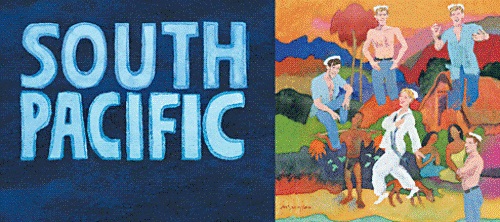
Although book editor and university instructor James Michener could have avoided military service in World War II as a birthright Quaker, he enlisted in the U.S. Navy in October 1942. He was not sent to the South Pacific theater until April 1944, when he was assigned to write a history of the Navy in the Pacific and was allowed to travel widely. He survived a plane crash in New Caledonia; the near-death experience motivated him to write fiction, and he began listening to the stories told by soldiers. One journey took him to the Treasury Islands, where he discovered an unpleasant village populated by "scrawny residents and only one pig" called Bali-ha'i. Struck by the name, Michener wrote it down and soon began to record his version of the tales on a battered typewriter. On a plantation on the island of Espiritu Santo, he met a woman named Bloody Mary; she was small, almost toothless, her face stained with red betel juice. Punctuated with profanity learned from GIs, she complained endlessly to Michener about the French colonial government, which refused to allow her and other Tonkinese to return to their native Vietnam, lest the plantations be depopulated. She told him also of her plans to oppose colonialism in French Indochina. These stories, collected into Tales of the South Pacific, won Michener the 1948 Pulitzer Prize for fiction.
There are nineteen stories in Tales of the South Pacific. The stories stand independently but revolve around the preparation for an operation by the American military to dislodge the Japanese from a nearby island. This operation, dubbed Alligator, occurs in the penultimate story, "The Landing at Kuralei". Many of the characters die in that battle – the last story is called "The Cemetery at Huga Point." The stories are thematically linked in pairs: the first and final stories are reflective, the second and eighteenth involve battle, the third and seventeenth involve preparation for battle, a pattern which continues numerically. The tenth story, at the center, however, is not paired with any other. This story, "Fo' Dolla' ", was one of only four of his many works that Michener later admitted to holding in high regard. It was the one that attracted Rodgers and Hammerstein's attention for its potential to be converted into a stage work.
"Fo' Dolla' ", set in part on the island of Bali-ha'i, focuses on the romance between a young Tonkinese woman, Liat, and one of the Americans, Marine Lieutenant Joe Cable, a Princeton graduate and scion of a wealthy Main Line family. Pressed to marry Liat by her mother, Bloody Mary, Cable reluctantly declines, realizing that the Asian girl would never be accepted by his family or Philadelphia society. He leaves for battle (in which he will die) as Bloody Mary proceeds with her backup plan, to affiance Liat to a wealthy French planter on the islands. Cable struggles, during the story, with his own racism: he is able to overcome it sufficiently to love Liat, but not enough to take her home.
Another source of the musical is the eighth story, "Our Heroine", which is thematically paired with the twelfth, "A Boar's Tooth", as both involve American encounters with local cultures. "Our Heroine" tells of the romance between Navy nurse Nellie Forbush, from rural Arkansas, and a wealthy, sophisticated planter, Frenchman Emile De Becque. After falling in love with Emile, Nellie (who is introduced briefly in story #4, "An Officer and a Gentleman") learns that Emile has eight daughters, out of wedlock, with several local women. Michener tells us that "any person ... who was not white or yellow was a nigger" to Nellie, and while she is willing to accept two of the children (of French-Asian descent) who remain in Emile's household, she is taken aback by the other two girls who live there, evidence that the planter had cohabited with a darker Polynesian woman. To her great relief, she learns that this woman is dead, but Nellie endangers her relationship with Emile when she is initially unable to accept that Emile "had nigger children." Nellie overcomes her feelings and returns to spend her life with her plantation owner.
Additional elements of South Pacific had their genesis in others of Michener's nineteen tales. One introduces the character of Bloody Mary; another tells of a British spy hidden on the Japanese-controlled island who relays information about Japanese movements to Allied forces by radio. Michener based the spy, dubbed "the Remittance Man", on Captain Martin Clemens, a Scot, who unlike his fictional counterpart, survived the war. The stories also tell of the seemingly endless waiting that precedes battle, and the efforts of the Americans to repel boredom, which would inspire the song "There Is Nothing Like a Dame". Several of the stories involve the Seabee, Luther Billis, who in the musical would be used for comic relief and also to tie together episodes involving otherwise unconnected characters.

.png)
.png)




